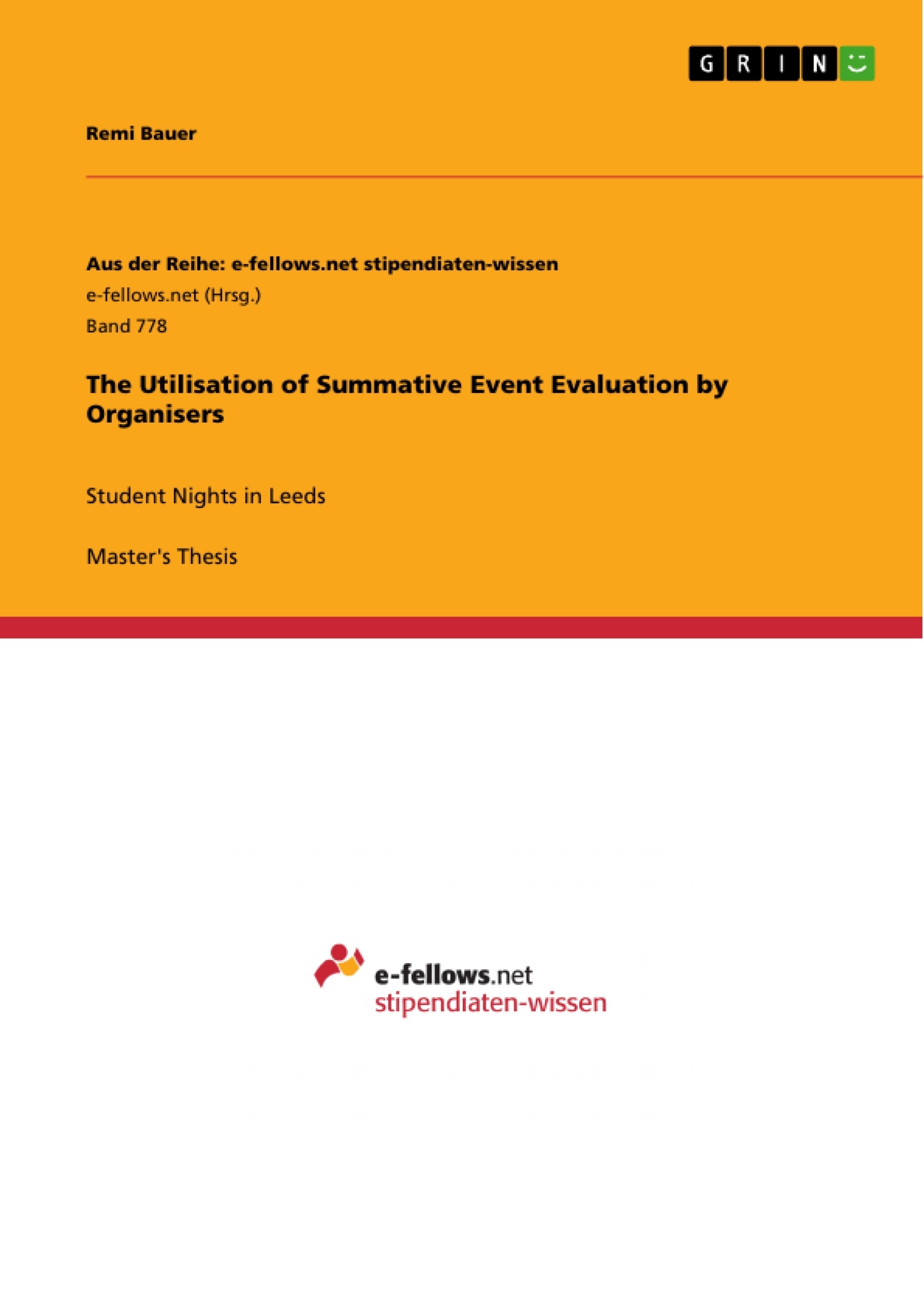In the events industry, post-event evaluation is becoming more and more recognised as a respected management tool for measuring success and a utensil for specifying whether objectives are accomplished. Yet, publications by academics and scholars have mostly overlooked the area which investigates the approaches organisers take for evaluating their events. To address this research gap, this study examines the evaluation approaches taken by student night organisers within the city of Leeds.
Student nights are defined as events taking place during late-night hours, being part of the night-time economy, which is a unique, unrepeatable and spatio-temporally restricted happening that specifically targets the student market of a city. The paper outlines that this is a relevant market segment for event organisers due to its size.
With an internet content analysis and an online questionnaire, student night organisers’ opinions on evaluation and their approaches to assess success were investigated.
With the empirical research, the dissertation shows that post-event evaluation theories, specifically goal-attainment models, are put partially into practice within the night-time economy. However, student night organisers in the city of Leeds do not take advantage of the full potential offered by the utilisation of summative event evaluation due to inconsistencies within the evaluation processes and frequencies. Further, the study identifies that organisations in the night-time economy measure success and assess performance when organising student nights mostly via economic objectives such as profit, cost and attendee numbers.
Inhaltsverzeichnis (Table of Contents)
- CHAPTER ONE: INTRODUCTION
- 1.1 BACKGROUND
- 1.2 AIMS
- 1.3 OBJECTIVES
- 1.4 SIGNIFICANCE AND VALUE
- 1.5 STRUCTURE OF THE DISSERTATION
- CHAPTER TWO: LITERATURE REVIEW
- 2.1 INTRODUCTION
- 2.2 NIGHT-TIME ECONOMY
- 2.2.1 THE CONCEPT OF NIGHT-TIME ECONOMY
- 2.2.2 ECONOMIC VALUE OF THE NIGHT-TIME ECONOMY
- 2.2.3 MARKET SEGMENTATION
- 2.2.4 STUDENT NIGHTS
- 2.2.5 Leeds' STUDENT NIGHTS MARKET
- 2.3 EVALUATION
- 2.3.1 EVALUATION: BACKGROUND
- 2.3.1 TYPES OF EVALUATION
- 2.3.2 MODELS OF EVALUATION
- 2.3.3 POST-EVENT EVALUATION
- 2.3.3.1 Importance of Post-Event Evaluation
- 2.3.3.2 Conducting Post-Event Evaluation
- 2.4 SUMMARY
- CHAPTER THREE: METHODOLOGICAL PROCESS AND METHODS
- 3.1 INTRODUCTION
- 3.2 RESEARCH PROCESS
- 3.3 UNDERSTAND RESEARCH PHILOSOPHY AND APPROACH
- 3.3.1 RESEARCH PHILOSOPHY
- 3.3.2 RESEARCH QUESTIONS
- 3.3.3 RESEARCH APPROACH
- 3.3.4 ROLE OF THE RESEARCHER
- 3.4 FORMULATE RESEARCH DESIGN
- 3.5 NEGOTIATE ACCESS AND Address EthicAL ISSUES
- 3.5.1 ACCESS
- 3.5.2 ETHICS
- 3.6 PLAN AND EXECUTE DATA COLLECTION
- 3.6.1 SAMPLING METHODS
- 3.6.2 PARTICIPANTS
- 3.6.3. DATA COLLECTION
- 3.6.3.1 Internet Content Analysis
- 3.6.3.2 Questionnaire
- 3.6.3.3 Interviews
- 3.6.3.4 Justification
- 3.7 LIMITATIONS
- 3.8 SUMMARY
- CHAPTER FOUR: ANALYSIS AND DISCUSSION
- 4.1 INTRODUCTION
- 4.2 INTERNET CONTENT ANALYSIS
- 4.2.1 RESULTS
- 4.2.2 DISCUSSION
- 4.3 QUESTIONNAIRE
- 4.3.1 STRUCTURE
- 4.3.2 RESULTS
- 4.3.3 DISCUSSION
- 4.4 ANSWERS TO THE RESEARCH QUESTIONS
- 4.4.1 RQ1: STUDENT NIGHTS' MARKET
- 4.4.2 RQ2: MEASURING SUCCESS
- 4.4.3 RQ3: GOAL-ATTAINMENT METHOD
- 4.5 SUMMARY
Zielsetzung und Themenschwerpunkte (Objectives and Key Themes)
This dissertation aims to investigate the evaluation approaches taken by student night organizers in Leeds, examining how they measure success and utilize summative event evaluation. The study explores the role of post-event evaluation in the context of the night-time economy, focusing on the unique challenges and opportunities presented by the student market. Here are some key themes explored in the dissertation:- Post-event evaluation in the events industry
- The night-time economy and its significance
- Student nights as a specific market segment
- Goal-attainment models of evaluation
- Economic objectives and their impact on evaluation practices
Zusammenfassung der Kapitel (Chapter Summaries)
- Chapter One: Introduction provides background information on the dissertation's topic, outlining its aims, objectives, and significance. It also presents the structure of the dissertation.
- Chapter Two: Literature Review explores the theoretical framework surrounding the night-time economy, student nights, and evaluation practices. It delves into the concept of the night-time economy, its economic value, market segmentation, and the specific characteristics of student nights. The chapter further examines various types and models of evaluation, focusing on post-event evaluation and its importance.
- Chapter Three: Methodological Process and Methods outlines the research methodology employed in the dissertation. It explains the research process, philosophy, and approach, including the research questions and the role of the researcher. The chapter details the data collection methods used, such as internet content analysis, questionnaires, and interviews, and discusses the justification for these methods.
- Chapter Four: Analysis and Discussion presents the results of the data analysis, focusing on the internet content analysis and the questionnaire. It discusses the findings and their implications for the research questions, exploring how student night organizers measure success and utilize goal-attainment models of evaluation.
Schlüsselwörter (Keywords)
This dissertation explores the utilization of summative event evaluation by student night organizers in Leeds, focusing on the night-time economy, post-event evaluation, goal-attainment models, economic objectives, and the student market. It investigates the evaluation practices of organizers within this unique and dynamic market segment.- Quote paper
- Remi Bauer (Author), 2012, The Utilisation of Summative Event Evaluation by Organisers, Munich, GRIN Verlag, https://www.grin.com/document/232080



